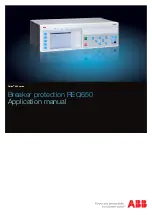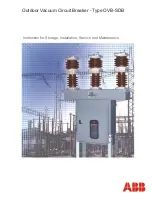
Manual Charge Handle
Manual Charge Handle Socket
Front Crank Assembly
Pivot Pin
Mounting Bracket
Rear Crank Assembly
Crank Pin
Manual Charge Cams (3)
Crank Shaft
Claw Stop
Figure 4-3 Manually Operated Spring-Charging Mecha-
nism Details
version. This is one way to quickly identify a manually
or power operated circuit breaker. The manual charging
mechanism on a power operated circuit breaker operates
on a ratchet principle, requiring 10 to 12 handle pumping
operations to completely charge the springs. When charged,
a definite metallic “click” is heard and the spring charge indi-
cator on the front control panel will show “Spring Charged.”
Do not try to force the charging handle beyond this point.
Closing of the circuit breaker is accomplished electrically
by an electromagnet (spring release device) which lifts the
closing spring release latch. Like the manually operated
circuit breaker, the power operated circuit breaker can also
be closed manually by pushing the front control panel close
bar (Figure 3-3).
Power operated circuit breaker can be opened manually or
electrically. Refer to paragraph 3-8.2 for details.
4-2.1 Spring Charge Mechanism for Power Operated
Breakers
The mechanism in a power operated circuit breaker is graphi-
cally illustrated in Figure 4-4.
Figure 4-5 is a front view drawing showing the principal parts
of the spring-charging portion of this mechanism. Some
parts are omitted for clarity. Figure 4-6 shows in greater
detail the major parts of the spring-charge mechanism in the
two basic positions:
1. Closing springs charged as viewed looking into right end
of crankshaft (Figure 4-6a)
2. Closing springs discharged partial view
Refer to Figure 4-5. The basic elements are mounted on
the crank shaft (8). This is a straight shaft with four flats
machined on it, and a crank arm (11) attached to each end.
Each crank arm connects to its closing spring (9) by a formed
spring end (10) in Figure 4-6b. The rear of the springs anchor
to the rear of the mechanism frame. The crank arms (11),
motor cutoff switch cam (7), close cam (6) and two drive
plates (25) have matching flats, and are thus anchored to the
crank shaft. The spring charge indicator (12) ratchet wheel
(17), oscillator (30), and emergency charge device (26) do not
have internal flats, but are mounted on separate bushings
and are free to rotate on the crank shaft.
The motor crank shaft assembly (29), carrying a roller for
driving the oscillator, is pivoted in the right hand mechanism
side frame. The hold pawl (18) is mounted by means of a pin
on the mechanism side frame.
In operation, rotation of the motor crank pushes the oscil-
lator arm counterclockwise to make the oscillator pawl (28)
push a tooth in the ratchet wheel (17), and rotate the ratchet
wheel slightly more than one tooth in the counterclockwise
direction. The holding pawl snaps behind the corresponding
advanced tooth, and holds it against the torque of the clos-
ing springs while the oscillator arm rotates back clockwise to
catch another ratchet tooth. Thus the ratchet wheel is rotat-
ed counterclockwise until the ratchet wheel pin (21) engages
the two drive plates (25), which in turn rotate the crank shaft
and crank arms in the same direction until the arms are
slightly past horizontal dead center. Since the close cam (6)
is rigidly mounted on the crank shaft like the drive plates, it
has rotated the same amount as the plates. The close cam
carries as stop roller as shown in Figure 4-7b. Just after
Effective July 2010
Instructional Book
IB694C694-03
31
eaton corporation
www.eaton.com
















































